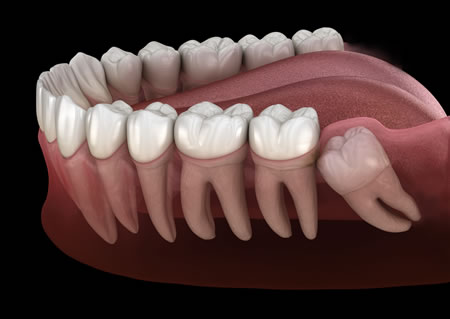There are several reasons why a person may need a dental extraction, including:
- Crowded teeth: If a person has too many teeth for their jaw size, their dentist may recommend extracting one or more teeth to make room for the others to align properly.
-

Impacted Wisdom Tooth
Impacted teeth: Impacted teeth are teeth that are stuck in the gums or bone and cannot erupt through the surface of the gums. Impacted teeth can cause pain, infection, and damage to nearby teeth, so they may need to be extracted.
- Infected teeth: If a tooth becomes infected or abscessed, it may need to be extracted to prevent the infection from spreading to other teeth or to other parts of the body.
- Wisdom teeth: Wisdom teeth, or third molars, are the last teeth to emerge in the mouth. They often do not have enough room to come in properly, which can cause pain, infection, and damage to nearby teeth. In these cases, wisdom teeth may need to be extracted.
- Teeth with advanced decay: If a tooth is severely decayed or damaged and cannot be repaired with a filling, crown, or other restoration, it may need to be extracted.
- Teeth with advanced periodontal disease: Periodontal disease is an infection of the gums and the supporting structures of the teeth. If the infection is not treated, it can destroy the gums and the bone that holds the teeth in place, leading to tooth loss. In these cases, the infected teeth may need to be extracted to prevent further damage.
What is the process for a dental extraction?
The process for a dental extraction typically involves the following steps:
- Consultation: During the initial consultation, the dentist will examine the tooth to be extracted and discuss the options for treatment with the patient. The dentist will also take X-rays of the tooth to determine its position and assess the health of the surrounding teeth and gums.
- Anesthesia: Before the extraction, the dentist will numb the area around the tooth with local anesthesia. This will help to prevent any pain or discomfort during the procedure.
- Loosening the tooth: In most cases, the dentist will use a tool called an elevator to gently loosen the tooth and separate it from the surrounding tissue.
- Removing the tooth: Once the tooth is loosened, the dentist will use forceps to grasp the tooth and carefully remove it from the mouth. In some cases, the tooth may need to be broken into smaller pieces to make it easier to remove.
- Stitching the gums: If necessary, the dentist may use stitches to close the opening in the gums where the tooth was removed.
- Recovery: After the extraction, the dentist will provide the patient with instructions for caring for the extraction site and managing any pain or discomfort. The patient will need to avoid eating or drinking anything until the anesthesia has worn off, and they will need to avoid brushing or flossing the area for the first 24 hours. The extraction site will typically heal within a few days to a week.
